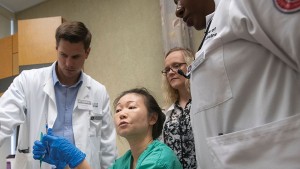
Dr. William M. Scholl College of Podiatric Medicine Dean Stephanie Wu, DPM, MSc, FACFAS, was honored with Podiatry Management magazine’s Lifetime Achievement Award and induction to the Podiatric Hall of Fame on July 30, 2022, during The National, the American Podiatric Medical Association’s (APMA) annual scientific meeting. Dr. Wu is at the forefront of a renaissance in podiatric surgical education, research and practice.
Helix: You are the first woman podiatric physician to be named to the Podiatric Hall of Fame, which, by the way, includes quite a few Scholl College graduates. How does that feel?
SW: It’s such a great honor to have been voted into the Hall of Fame by my peers. But I was actually a little surprised that I was the first woman podiatric physician. There are so many great women that came before me, like Kathleen Stone, DPM ’85, the first female APMA president; Sylvia Virbulis, DPM ’85, APMA president-elect; and current President Laura Pickard, DPM ’90, the second woman to lead APMA. Then there’s our own Nancy Parsley, DPM, MHPE, the first woman dean of Scholl College and the first doctor of podiatric medicine to be named a university provost. These amazing women not only serve as my role models, but their remarkable accomplishments helped pave the path for me, and I am deeply grateful.
Announcement of your award was accompanied by tributes that mention your kindness and humility, qualities illustrated by your first meeting with David Armstrong, DPM, the founding director of the Center for Lower Extremity Ambulatory Research (CLEAR). Shortly after that meeting, he recruited you as Scholl College’s first limb preservation fellow.
I did my residency in the Washington, D.C. area and when we learned that he was in town for a meeting with the FDA, he kindly offered to meet the residents. The FDA is in Maryland, and we were at Inova Fairfax Hospital in Virginia. In D.C. traffic, he was hours away. I felt bad about sending a junior resident to pick him up. Who wants to sit in traffic for two hours with somebody they don’t know? I was the chief resident. I could have assigned someone else. But then I thought, “No, it’s my duty. I’ll go.” That decision turned out to be pivotal to my professional path.
“I’m always aware that our work is a team effort.”
What has it been like to be a woman in academic leadership?
I’m always aware that our work is a team effort. Whether it’s patient care or administrative duties, you need that team of support and just really valuing everyone’s insights, thoughts and contributions to help make the best and most informed decisions. We’re all working toward the same goal — to best serve our patients and/or students depending on the situation. I came to RFU from residency training where that hierarchy was very much in place. So, as a student, you talked to the first-year resident, as a first-year resident, you talked to the second-year resident, and so on. You don’t really see that at RFU, where everyone is kind and just really, really helpful. I think of Wendy Rheault, our president, and Nancy Parsley, our provost. They’re team players. Caring and respectful. You don’t feel that hierarchy with them. Knowing that I’m in an environment where I can potentially serve as a role model for work-life balance, especially for female students and for younger faculty members, is very rewarding. Because when they see you do it, they’re like, “Oh, I can do it too.”
You have received international recognition for your work in limb preservation and the treatment of diabetic wounds.
I feel very fortunate to be at RFU because of our strong research focus and our commitment to discovering new means of treatment and prevention. Diabetes and its associated complications to the lower extremity is a very, very costly disease. One of the issues that we deal with is recurrence. We can help heal diabetic wounds, but they come back because the pressure on the feet is always there. So our research is focusing on how to speed healing when ulcers occur to help prevent infections and amputations, and prevent ulcer recurrence once they are healed. That all adds up to saving lives. The costs associated with diabetes and its complications are more than just measurable healthcare costs. They also include lost productivity — not only for the patients themselves, but also for their family and loved ones who have to drive them to doctors’ appointments and help with dressing changes. We want to prevent wounds that devastate patients’ lives and mobility. One area of our research is angiogenesis — the regeneration of blood vessels. Many people with diabetes are affected by a lack of adequate blood flow and that can lead to the need for amputation. So looking at growth factors to help regenerate blood vessels is really important. We’re also looking at treating wounds with human umbilical cord tissue — at how that treatment can help with not only regeneration but regeneration with less scarring and decreased recurrence. So we’re harnessing the body’s own technology, in essence, to speed and improve healing.
Judy Masterson is a staff writer with RFU’s Division of Marketing and Brand Management.